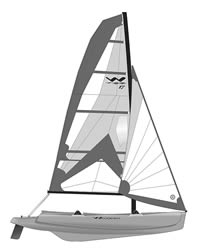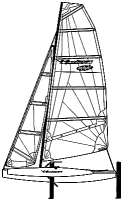Windrider 17 & Walker Bay 10
Windrider 17 & Walker Bay 10
Daysailer and Dinghyr
In addition, there's a lot of fun to be had in small boats. I have had some really good sails with my 6-foot, 3-inch 220-pound body press-fit into an 8-foot El Toro dinghy.
I think you would stay pretty dry in this WindRider 17 designed by Jim Brown and the WindRider group. It certainly won't heel with those amas, so your chance of capsize has been greatly reduced compared to that of a monohull. This is a rotomolded boat, so it's pretty much indestructible. This makes it ideal for sailing off the beach especially if your beach is rocky like mine.
The beauty of this 17-footer is that with its trampolines between the main hull and the amas you have a lot of sitting space. You can carry four in comfort with one on each tramp. The helmsman sits aft in a dedicated helm cockpit and steers with his or her feet. Ergonomically the entire WindRider line is designed for comfort with contoured seats and big radiuses on all edges. We'll forget about D/Ls this month, but we will examine the SA/Ds. To do this with any accuracy we better include the weight of the typical crew with the boat's displacement. A husband and wife crew on a 20,000-pound boat represents only 1.65 percent of the displacement. That same weight on the WindRider 17 will increase the displacement by 100 percent. So, with our 320-pound crew the WindRider 17 has an sa/d of 29.9, if you include the optional jib. If you add two kids to increase the total crew weight to 520 pounds, you reduce the sa/d to 24.9. There is no centerboard or daggerboard on this model, in part because these features do not easily lend themselves to rotomolding.
We'll forget about D/Ls this month, but we will examine the SA/Ds. To do this with any accuracy we better include the weight of the typical crew with the boat's displacement. A husband and wife crew on a 20,000-pound boat represents only 1.65 percent of the displacement. That same weight on the WindRider 17 will increase the displacement by 100 percent. So, with our 320-pound crew the WindRider 17 has an sa/d of 29.9, if you include the optional jib. If you add two kids to increase the total crew weight to 520 pounds, you reduce the sa/d to 24.9. There is no centerboard or daggerboard on this model, in part because these features do not easily lend themselves to rotomolding.
As for the Walker Bay 10, I already own two of the company's 8-footers. I keep one for my tender and one for my beach dink. I like these boats. They could have easily looked like garbage cans, but with their simulated lapstrakes for stiffening and springy sheers they look quite proper. A little blue tape could provide a nice cove stripe if you just followed a line half an inch above the upper "strake." These boats are injection molded, which requires very expensive tooling, but the result is a far nicer boat than most rotomolded models, while still being light and durable. I just slide mine down the rocks like a sled.
Still, two people is a crowd in my 8-footer, so Walker Bay has introduced a 10-footer that can easily take on two for sailing or three for rowing. And these boats do row well. That along with their aesthetics was their specific appeal for me.
With daggerboard, kick-up rudder and small rig the Walker Bay should sail just fine. It's no Laser, but when you are out there by yourself, speed is relative. With my 220 pounds added to the 115 pounds of the boat, the sa/d is a wee 14.4. But make no mistake, this little boat is no toy.
A tough, practical dinghy and a fun, stable daysailer. kpit. This boat will not be a pointer and I would guess if you get everything trimmed just right you could expect an efficient on-the-wind apparent wind angle of 39 degrees. But with this hull form there is no sense in jamming the boat up any higher.
Having just returned from the Annapolis boat show I can tell you with confidence that we live in a "me too" world. The "bloated tennis shoe" look, as my pal Tom calls it, is everywhere. It's a pleasure to review a design by a designer and yard that have said, "We'll do it our way."

Comments